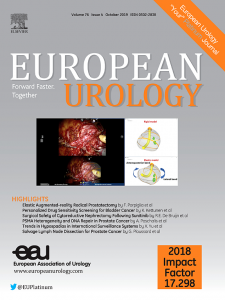CaboPoint:一项基于检查点抑制剂联合治疗转移性肾细胞癌患者后二线卡博赞替尼的2期研究
IF 25.2
1区 医学
Q1 UROLOGY & NEPHROLOGY
引用次数: 0
摘要
背景和目的在标准的一线检查点抑制剂(CPI)联合治疗晚期肾细胞癌(aRCC)后,纯二线卡博赞替尼的使用数据有限。我们报告CaboPoint前瞻性研究的最终结果。方法2期、多中心、开放标签的CaboPoint研究(NCT03945773)评估了二线卡博赞替尼治疗成人aRCC的有效性和安全性,在先前的伊匹单抗加纳沃单抗(IpiNivo;队列A)或CPI治疗加血管内皮生长因子靶向治疗(队列B)之后。主要终点是根据实体肿瘤反应评价标准1.1的客观缓解率(ORR),通过独立中心评价(ICR)在队列a中进行评估。次要终点包括队列B中ICR的ORR,研究者评价的ORR,无进展生存期,总生存期和安全性。总体而言,从2020年到2023年,来自40个机构的127名患者入组。中位随访时间为19.3个月。队列A的ICR orr(95%可信区间[CI])为40.5%(29.6-52.1%)(具有统计学意义和临床意义),队列B的orr为27.5% (14.6-43.9%);根据研究者回顾,队列A的orr为49.4%(38.4-60.5%),队列b的orr为33.3%(19.6-49.5%)。队列A的中位无进展生存期为10.9(8.2-14.2)个月,队列b的中位无进展生存期为8.3(5.6-11.1)个月。队列间的中位总生存期(95% CI)相似(分别为24.3[18.5-31.8]和24.1[17.1 -不可计算]个月)。没有新的安全隐患。结论和临床意义:scabopoint是第一个在一线cpi联合治疗后使用纯二线卡博赞替尼的研究,为未来的二线aRCC研究提供了一个基准。本文章由计算机程序翻译,如有差异,请以英文原文为准。
CaboPoint: A Phase 2 Study of Second-line Cabozantinib After Checkpoint Inhibitor–based Combination Therapy in Patients with Metastatic Renal Cell Carcinoma
Background and objective
Data are limited regarding pure second-line cabozantinib use after standard first-line checkpoint inhibitor (CPI)-based combination therapy for advanced renal cell carcinoma (aRCC). We report the final results from the prospective CaboPoint study.Methods
The phase 2, multicentre, open-label CaboPoint study (NCT03945773) evaluated the efficacy and safety of second-line cabozantinib in adults with aRCC, after prior ipilimumab plus nivolumab (IpiNivo; cohort A) or CPI therapy plus vascular endothelial growth factor-targeted therapy (cohort B). The primary endpoint was objective response rate (ORR) as per Response Evaluation Criteria in Solid Tumors 1.1, evaluated by independent central review (ICR) in cohort A. The secondary endpoints included ORR by ICR in cohort B, ORR by investigator review, progression-free survival, overall survival, and safety.Key findings and limitations
Overall, 127 patients were enrolled from 2020 to 2023 across 40 institutions. The median follow-up was 19.3 mo. ORRs (95% confidence interval [CI]) by ICR were 40.5% (29.6–52.1%) in cohort A (statistically significant and clinically meaningful) and 27.5% (14.6–43.9%) in cohort B; according to the investigator review, ORRs were 49.4% (38.4–60.5%) in cohort A and 33.3% (19.6–49.5%) in cohort B. The median (95% CI) progression-free survival was 10.9 (8.2–14.2) mo in cohort A and 8.3 (5.6–11.1) mo in cohort B. The median (95% CI) overall survival was similar between cohorts (24.3 [18.5–31.8] and 24.1 [17.1–not calculable] mo, respectively). There were no new safety concerns.Conclusions and clinical implications
CaboPoint is the first study of pure second-line cabozantinib after first-line CPI-based combinations, providing a benchmark for future second-line aRCC studies.求助全文
通过发布文献求助,成功后即可免费获取论文全文。
去求助
来源期刊

European urology
医学-泌尿学与肾脏学
CiteScore
43.00
自引率
2.60%
发文量
1753
审稿时长
23 days
期刊介绍:
European Urology is a peer-reviewed journal that publishes original articles and reviews on a broad spectrum of urological issues. Covering topics such as oncology, impotence, infertility, pediatrics, lithiasis and endourology, the journal also highlights recent advances in techniques, instrumentation, surgery, and pediatric urology. This comprehensive approach provides readers with an in-depth guide to international developments in urology.
 求助内容:
求助内容: 应助结果提醒方式:
应助结果提醒方式:


